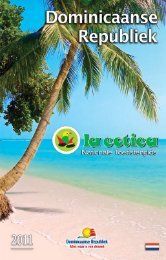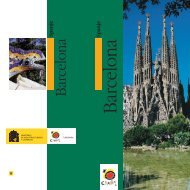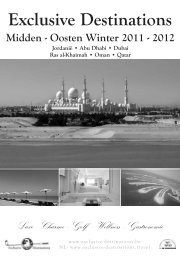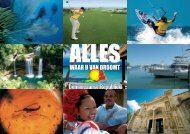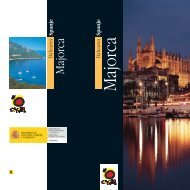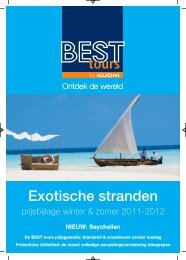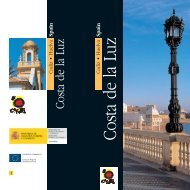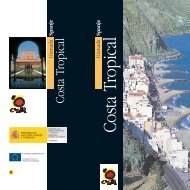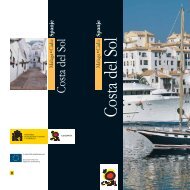You also want an ePaper? Increase the reach of your titles
YUMPU automatically turns print PDFs into web optimized ePapers that Google loves.
Green <strong>Spain</strong> <strong>Spain</strong>Green <strong>Spain</strong> <strong>Spain</strong>EUROPEAN COMMUNITYEuropean RegionalDevelopment FundGaliciaAsturiasCantabriaThe BasqueCountryI
IndexIntroduction 2Galicia 4AsturiasCantabriaThe Basque Country202836<strong>Spain</strong>1
The northern coast of <strong>Spain</strong> is the consecration of the colorgreen. From the meadows of the interior, right up to theborders of the cliffs, all things take on a shade of green. The price is aconstant fine rain that nourishes the land, brings harmony to thelandscape, and maintains the hydrographic balance.Craggy mountains loom over the Atlantic Ocean and the CantabrianSea, which have chiseled spectacular cliffs, producing smallsheltered ports, beaches of fine sand, and secluded coves abovewhich sea gulls soar. Its inhabitants –Celts, Asturians, Cantabrians,and Basques– protected by nature, have withstood the advances ofRome, the Arabs, as well as invaders that came by sea.In Galicia, Santiago emerged as a focal point for Christianpilgrimages. In Asturias, the Reconquest began; the struggle againstthe Arab invaders that lasted almost seven centuries. From Cantabria,the foramontanos departed in the 9th century to repopulate Castile,devastated by war. In the Basque country, the oldest language knownin the western world has been preserved: Euskera.It was easier to reach these four communities of the northern coastby sea. The mountainous regions of the interior, covered with forestsand with almost no roads, were crossed by few travellers –most ofthem trekking to Santiago de Compostela– and these isolated areashave preserved not only their landscapes but also their customs andtraditions. Sea-faring and agricultural lands, a journey through «Green<strong>Spain</strong>» will please even the most demanding visitor.GaliciaAsturiasCantabriaThe Basque Country23
G A L I C I AIn the northwest corner of the Iberian peninsula, embraced by asea filling it with fjord-like rías (estuaries), beaches and islands,and surrounded by mountains that have isolated it throughouthistory –with the exception of the pilgrimage roads– we findthis lush green land of almost 30,000 square kilometers(18,500 square miles) divided into four provinces: A Coruña, Lugo,Ourense and Pontevedra. Of the four, Ourense is the only landlockedprovince but, as compensation, it boasts the highest mountains.The symbols of Galicia include the cruceiro, an elaborately carvedstone cross on a tall column (for praying), and the hórreo (forstoring grain), sheds made of stone or wood with narrow slits,raised on stilts; symbols which could be interpreted as the spiritand the substance. But in order to better understand Galicia, itssmall villages must be contemplated shrouded in a fine mist; alandscape which has remained unchanged for centuries.Castrelo de Miño4
OURENSEGaliciaRoman historians tell about the firstlegionary forces that came ashorehere. Upon their arrival at thelagoon of Antela in the region of ALimia, the dense fog caused themto believe they had reached theLethe, the river of forgetfulness inHades according to Greekmythology, and they refused tocontinue. The Proconsul incommand had to cross the river firstby himself and call to the soldiersRibeira Sacra along Sil Riverfrom the other side to prove it wasonly an ordinary river.Today the lagoon of Antela, once one of the largest wetlands in thepeninsula, no longer exists, and a large part of the legends surrounding ithave disappeared along with it. But the ecological importance of thisregion of Baixa Limia continues to be great, and it is one of the richestecosystems in Galicia due to the abundance of species of birds that nesthere, including the gray heron, the stork, and a large number of anatidae.Nearby, we find Monterrei castle, one of the best preserved in allGalicia.But the loveliest region in Ourense is Ribeira Sacra, so-named becauseof the numerous monasteries erected along the banks of the river Silfrom the 6th to the 12th centuries. The most important ones are theMonasteries of San Estevo, San Pedro de Rocas, Santa Cristina deRibas de Sil, Santa María de Xunqueira, and Santa María deMontederramo. Here we come upon Sil Canyon, the most spectacularone in Galicia, a unique and privileged setting that surely caused themonks to choose such charming spots for retreat.Miño River in OurensePontevedra RíaPONTEVEDRAMonte Aloia, near the fortress-city of Tui, was the first site in Galicia tobe declared a nature park and is an excellent scenic lookout forcontemplating the Ría de Vigo and the valley of the Louro river, whichowes its name to the large gold nuggets once found on its riverbed.Further north, this river forms the Gándaras de Budiño lagoons andboasts one of the largest prehistoric finds in all Galicia, as well as animportant bird observatory. The Louro flows into the Miño River providinga natural boundary with Portugal. Galicia is a land of a thousand rivers,and the Miño, flowing through three of its four provinces, is its principalartery. Along its banks, we encounter the remains of fortresses,Romanesque churches, hermitages, stone crosses, numerous vineyards(remember, this is wine country), and right at the mouth of the river, theCeltic hut of Santa Tegra. One of the prehistoric paintings here maypossibly represent the oldest «map» in the Western world depicting themouth of the Miño river and Santa Tegra mountain. This area of the Miñois an important haven for aquatic birds, and the vegetation primarilyconsists of pine trees. Overlooking the Atlantic Ocean and at the foot ofSanta Tegra, we find A Guarda, famous for its lobsters. From here,skirting up the jagged coast, we reach the Cistercian monastery of SantaMaría de Oia, where monks once hid cannons in the bell tower to useagainst invaders. Further north, we come to Baiona, a busy tourist town;the impressive circuit of walls of Monterreal (three kilometers of walls),has now been converted to a Tourist Parador. Between Baiona and Vigo,7
GaliciaA CORUÑAGaliciathere are numerous beachesof fine white sand: PlayaAmérica, Panxón, Canido,Senil. In the interior, herds ofwild horses graze, and at thebeginning of summer, theyare brought in to be brandedand have their manes cut;this colorful rapa das bestas(wild horse roundup) usuallyGalician Granaries in Combarro ends with a romería(pilgrimage or celebration ata local shrine). The coast ofPontevedra is generally craggy, but here we can also find the Rías Baixaswith lovely peaceful beaches. Legend says these estuaries are the signleft by the fingers of God when he cleansed after creating the earth. Atthe mouth of the Ría de Vigo, we encounter the Cíes Islands (NationalPark), discovered by the Phoenicians. They were a gathering place atone time for hippies, but now the several small isles form a National Parkwith beaches of white sand that can be reached by boat from Vigo.Proceeding towards the capital Pontevedra bordering the Morrazopeninsula, there are secluded places, including the coves of Aldán,Bueu and San Simón, the extraordinary stone cross of Hio, (theloveliest in all Galicia) and closing off the estuary, the Ons Islands, Onzaand Onceta with interesting fauna, especially the cormorant.Combarro, a short distance from Pontevedra, has the bestassembly of hórreos (granaries) in Galicia, along with stonecrosses. Nearby, at the Monastery of Poio, SaintTrahamunda was laid to rest; legend says she is able to cureall types of deafness. Further north is the Monastery of AArmenteira, surrounded by legends of a monkwho spent 300 years bewitched by a bird's song.Continuing along the coast, we come to thenature reserves of A Lanzada and O Grove,famous for their beaches and waters withhealing properties. Afterwards, we find Vilanova,now connected by a bridge to Arousa Island.The next place of interest is Padrón, a townwhich received its name from the mooringstone or pedrón where the boat anchoredbearing the remains of the Apostle SaintJames (Santiago in Spanish). This was theorigin of the pilgrimages to Santiago deCompostela, a city which is now the capitalof the Galician autonomy.After skirting along the Coruña part of theestuary, we come to A Pobra do Caramiñal,the «balcony of the Arousa estuary». Along theway, we have passed Catoira, where aninteresting Viking romería takes place the firstSunday in August, while beaches of golden sandand pine trees can be seen in the background.Nearby is another nature park, the CorrubedoDunes, consisting of large expanses of sand called arenales where we findthe highest dune in the northern part of the peninsula. One of the best scenicviews can be enjoyed from the Pico Curotíña, another nature reserve.At the end of the estuary which bears its name, after passing through thecharming town of Porto do Son, is Noia. Legends tell that it is one ofthe three cities founded in <strong>Spain</strong> by Tubal, grandson of Noah (the othersare Noega in Asturias and Noja in Cantabria). Its cemetery with Medievaltombstones merits a visit. Scattered on a hill, we encounter the town ofMuros, which preserves an impressive figure of Christ salvaged from ashipwreck.Cathedral in Santiago de CompostelaEnclosed Glass Balconiesin A CoruñaMilladoiro Cross in Noia89
GaliciaNext comes Monte O Pindo, at the beginning of the «Punta das Cabras»,where the Xallas river spills forth in a magnificent waterfall, the mostspectacular one in Galicia, only a short distance from the sea. Animportant archeological site, it is also considered to be magical. Whengazing upon the enormous rocks, it is not hard to imagine the areapervaded by magic.In this area, the coast is rugged and the sea, tumultuous, causingnumerous shipwrecks and earning it the name of the Costa da Morte(Coast of Death). At dusk, when the mist comes in, it is easy tounderstand why Cabo Fisterra (Land’s End) was considered the end ofthe world and was a religious mecca like San Andrés de Teixido waslater, and Santiago de Compostela continues to be. Afterwards, we findMuxía (with its swinging stone), Camariñas (famous for its laces),Cabo Vilán (declared a nature park), Laxe and Malpica. Near the latter,off San Adrián cape, we encounter the Sisargas Islands with theirlegends of snakes and an important reserve for marine animals.Via Carballo, which boasts a health spa with healing sodiumsulphurouswaters, we arrive at the capital, A Coruña, and its beaches,each one as lovely as the next; Riazor, Orzán, San Amaro and SantaCristina. Nearby is the sea-faring town of Sada, and only 24 kilometersaway, Betanzos, the Roman Brigantium, many say was founded by thelegendary Celtic hero, Breogan. Nearby, we find the A Mariña marshes,another of the important nature reserves. From Betanzos, passingPontedeume and its long beach of Cabanas, we arrive at Ferrol.Cabo VilánStone Cross and Beach at FisterraHigh above, protecting the estuary, rises a famous shrine housing themiraculous Christ of Chamorro, protector of sailors. A short distanceaway, we find the lagoon and arenal of Valdoviño, a sandy expanse withdunes and aquatic birds.Here the Rías Altas (Upper Estuaries) begin with colder water than theLower Estuaries but lovelier beaches. By a road half hidden in themountain, we arrive at Cedeira, an important fishing port, as well as asummer vacation resort. About twelve kilometers away (only seven bythe old dos romeiros road), we find San Andrés de Teixido, a placeevery Galician must visit at least once in a lifetime if he does not want tobe a soul in Purgatory (an old saying alleges that to San Andrés go thedead who have not gone during their lifetime). It was the most importantpilgrimage destination in <strong>Spain</strong> before Santiago de Compostela. It is stillpossible to see on both sides of the road, amilladoiros made with stonesthrown by the pilgrims, stones that on Final Judgement day «will speak»to tell who has fulfilled their promise of going to San Andrés. Here thenamoradoira plant grows which is said to solve problems of love.Here we find the Serra de Capelada and the nature reserves ofOrtigueira beach and the cape of Estaca de Bares, where the Atlanticmeets the Cantabrian Sea.1011
COSTA DA MORTE (COAST OF DEATH)GaliciaTraditional Celtic Houses at Serra dos Ancares, PiornedoLUGOThe Sor river separates the province of A Coruña from Lugo province, thelargest in Galicia. We now enter a land of valleys separated by mountainswith forests of oak, pine and eucalyptus trees. The first important place wecome to is Viveiro, and next is Chavín, with the oldest eucalyptus tree in<strong>Spain</strong> and the tallest trees (the tallest is the 64 meter/210 feetEl Abuelo meaning The Grandfather). Nearby, there are three naturereserves of great interest: the Coelleira and Ansarón Islands, and the Sorestuary. In Coelleira, there are 25 varieties of sea gulls and migratory birdsthat stop here on route from Greenland to Africa. Continuing our journey,we arrive at the beach of Covas with sand so fine that it is impossible tohold it in a closed fist. The best view of the coast can be enjoyed atop theNain. Everywhere you look there are beaches: San Cibrao, Cangas, Nois,Forxan, Foz... and pine trees and meadows among the rocky places. Nottoo far away, we find Sargadelos, which started out manufacturingcannons and ended up making famous porcelain. Near Foz is theMonastery of San Martín de Mondoñedo and, higher up, a smallRomanesque hermitage from where it is said Bishop San Gonzalo sank theNorman fleet using only Hail Marys in the 9th century; one boat for eachHail Mary. Finally, we arrive at the endmost beaches of Lugo, such as AsCatedrais in Ribadeo and the nature reserve of the Ría del Eo, a river ofsalmon and dwelling place for aquatic birds, bordering on Asturias.You can follow two routes inland: one from the Monastery of Meira atthe source of the Miño river to the Serra de O Courel, where centuries ofisolation have allowed the preservation of a privileged landscape,passing through the Serra de Os Ancares and their pallozas (conicalshapedhouses made of stone with thatched roofs); areas inhabited bycapercaillie (large grouse), wolves and roe deer. The other route begins inMondoñedo, cradle of spirituality of the Galician soul, Vilalba, athriving economic center, and Monforte de Lemos, an importantcommunications center.This is the name given to the inhospitable stretch of coast in the provinceof A Coruña between Cabo Fisterra and the Sisargas Islands. It hasacquired this name because of the number of ships that have smashedupon its reefs. The area is filled with reminders of old shipwrecks, suchas the beach dos difuntos queimados near Camariñas, called thisbecause they had to burn numerous corpses washed up by the sea; or thepedra do almirante, marking the spot where one of the ships from theInvincible Armada was destroyed. Other places that have sufferedtragedies caused by the sea are Fisterra, Muxía, Camelle, Laxe andCorme. We must not forgot the legendary city of Duio, located nearFisterra, which actually existed. According to legend, it was entombed bythe sea two thousand years ago on account of the sins of its citizens. Allof this region was inhabited during ancient times, as evidenced by thenumerous dolmens, such as Pedra Cuberta, Pedra da Arca, Freans orDombate.RAPA DAS BESTASBeginning the first Sunday in May and up until the second Sunday in July,the regions in Galicia with wild horses celebrate the traditional rapa dasbestas (wild horse roundup). A Valga, Torroña, Mougás, Morgadáns,Amil and Sabucedo in Pontevedra. O Barbanza and A Capelada in ACoruña, and Candaoso in Lugo are the most well-known. The process isalways the same. At dawn, the horses that roam free the rest of the yearare gathered by horsemen and led to curros (stone enclosures). Here thecolts are branded and manes and tales are cut. Then after the sale of afew of them, the rest are released until the next year.Wild Horse Roundup12
FESTIVALS IN GALICIAGaliciaGalicia– Carnival: Entroido in Xinzo de Limia (Ourense) and Entroido de Laza,Verín (Ourense).– Holy Week: Viveiro (Lugo) and Ferrol (A Coruña), Romería del SantoCristo in Fisterra (A Coruña) on Easter Sunday.– May: Ribeiro wine celebration in Ribadavia (Ourense).– Corpus Christi: flower carpets (in the streets) in Ponteareas(Pontevedra).– July: A Rapa das Bestas (Wild-horse round-up), San Lourenzo deSabucedo-A Estrada (Pontevedra) and Candaoso- San Andrés deBoimente, Viveiro (Lugo). Festival of San Bieito de Lérez (Pontevedra).– August: Wine Festival of Albariño in Cambados (Pontevedra). RomeríaVikinga in Catoira (Pontevedra). Festival of the Santa Cruz in Ribadeo(Lugo). Festa do Polbo in O Carballiño (Ourense). Festivals of SanLorenzo in Foz (Lugo). Xira dos Caneiros in Betanzos (A Coruña).Festivals of San Roque in Sada (A Coruña). Romería de O Naseiro inViveiro (Lugo). Festival of History in Ribadavia (Ourense).– September: A Nosa Señora da Barca in Muxía (A Coruña).– October: Seafood celebration in O Grove (Pontevedra). Festival of AsSan Lucas in Mondoñedo (Lugo). San Froilán (Lugo).HANDICRAFTSBobbin lacefrom CamariñasFerias (fairs) and romerías (pilgrimages or celebrations at local shrines) areinstitutions in Galicia and attract craftsmen still specializing in popular art.Clay continues to be crafted in Buño (A Coruña), Bonxe (Lugo), Niñodaguia(Ourense) and Salvaterra do Miño and Redondela (Pontevedra), andporcelain in Sargadelos (Lugo). Lace is made in Camariñas and Muxía(A Coruña), wooden shoes in Betanzos (A Coruña), dried bread figures inSan Andrés de Teixido (A Coruña), pottery in Gundivós (Lugo), silverobjects in Santiago de Compostela (A Coruña), baskets in Noia (A Coruña)and, cuévanos (baskets) from chestnut strips in Ribadavia (Ourense).Famous are the knives from the province capital Lugo, and the fabrics fromXinzo de Limia and Viana do Bolo (Ourense). Craftsmanship in stone canbe admired in the numerous cruceiros (stone crosses), calvarios (calvaries),and petos de animas (a type of altar for collecting alms for suffering souls)produced throughout the Galician lands.Ceramics fromSargadelos15
GALICIAN CUISINEThe quantity and variety of seafood found off Galicia's coasts must behighlighted, especially goose barnacles, oysters, lobsters, Norway lobster,and scallops. Octopus is served during pilgrimages to the interior; sardinesat festivals on the coast. Other dishes include empanadas (savory meat orfish pies), lacón con grelos (soup-stew of ham knuckle, turnip tops andpotatoes), hake, tuna, grouper, lamprey, turbot, and excellent cheeses.Queimada (a flaming potent liquer) and the wines must also be mentioned.Deserving special mention from A Coruña province are the filloas (creamfilledcrepes), tarta de Santiago (a moist almond cake), and the winesfrom Ulla and Betanzos. In Lugo, the sardines with cachelos (potatoes),savory pies made of sea trout or lamprey, and cachucha (pig‘s head). InOurense, the becadas (woodcock) from A Limia, cakes from Allariz, andthe famed wines of Ribeiro, Valdeorras and Monterrei. Last of all,Pontevedra’s cuisine consists chiefly of seafood and products from the sea,accompanied by the wines of Albariño, Rosal and Condado.Ortigueira RíaGALICIAN ISLANDSOf the almost five hundred kilometers of coastline in Galicia, threehundred pertain to islands. Some are of historic interest, especiallyToralla, Cíes, Ons and Arousa; others are bird-watching sites, such asSisargas or Malveiras, and still others are ideal for fishing, includingPedras do Co or Pena Alloeira. But there are many more, the majorityof them are practically unknown but are no less beautiful, such asMourón in the Ría de Pontedeume, Teirón in the area of Carballo, theromantic Roncudo, next to the cape bearing the same name, Onza nearOns, Bombardeira near Baiona, Gabeira in the Ría de Vivero,Percebelleira near the sandy arenal of Valdoviño, Lobeira Grande notfar from Concurbión, etc. Most of them can only be reached by smallboats and good swimmers!NATURAL AREAS OF GALICIAGalician ShellfishThe maritime-terrestrial Atlantic Islands National Park, including thearchipelago of the Cíes and Ons, and the nearby islands of Cortegada andSálvora.Nature Parks: Dune Complex of Corrubedo, and Carregal and VixánLagoons (A Coruña), Baixa Limia-Serra do Xurés (Ourense) andMonte Aloia (Pontevedra), Fragas do Eume (A Coruña), o Invernadero(Ourense), Serra da Encina da Lastra (Ourense).Nature Reserves of National Interest: Cabo Vilán, Cumbre de Curotiñaand Estaca de Bares (all three in A Coruña).Protected natural areas: Ría de Ortigueira (A Coruña), intersea complex ofO Grove, A Lanzada and Punta Carreirón (Pontevedra), arenal deValdoviño (A Coruña), Cecebre reservoir (A Coruña) and Ría del Eo (Lugo).Animal recovery centers: Santa Cruz (A Coruña), O Veral (Lugo), Altodo Rodicio (Ourense), and Cotorredondo (Pontevedra).Other places of interest: Fisterra (A Coruña), the eucalyptus trees of Chavín(Lugo), as Catedrais beach in Ribadeo (Lugo), and the Ribeira Sacra withthe canyon of the Sil river and the indigenous vegetation (Ourense).1617
MONUMENTAL CITIESGaliciaSantiago de Compostela. Declared a World Heritage City. Cathedral(Romanesque doorway and Baroque facade), Royal Hospital (currently aTourist Parador), Xelmírez Palace, Plaza de Platerías and Plaza deQuintana, Collegiate Church do Sar, and Monastery of San Martín Pinario.A Coruña. Torre de Hércules (Roman lighthouse), Churches of Santiago(12th century) and Santa María del Campo (13th century), María PitaPlaza, old walls, San Antón castle (16th century).Betanzos. Medieval walls, Churches of Santa María del Azogue(14th century), Santiago (Gothic) and San Francisco (Gothic), andO Pasatempo park.Muros. Church of San Pedro (15th century) and porticoed streets.Noia. Churches of San Martin (15th century) and Santa María la Nueva(with cemetery of medieval tombstones).Padrón. Church of Santiago(with the famous mooringstone), stone cross, and oldquarter.Lugo. Roman walls encirclingthe city, Plaza Mayor, Cathedral(Romanesque and Neoclassical),Episcopal Palace (18th century),Churches of Santo Domingo(12th century), San Francisco(13th century), and San Juan deDios (Baroque).Monforte de Lemos. Fortresswith homage tower, old walls,Palace of Los Alba, Monastery ofSan Vicente del Pino, andColegio de la Compañía(16th century seminary).Church ofSan Francisco in Betanzos18Mondoñedo. Romanesque-Gothic Cathedral, and Church ofLos Remedios (16th century).Viveiro. Puerta de Carlos V(gate), and Churches of SanFrancisco and Santa María.Ourense. Cathedral (Romanesque), As Burgas fountain, Puente Viejobridge (13th century), and old quarter.Allariz. Monastery of Santa Clara, Shrine of San Benito, RomanesqueChurches of Santiago, San Esteban and Santa María de Vilanova.Celanova. Monastery of San Salvador (18th century) with San Miguelchapel (10th century).Roman Walls in LugoRibadavia. Church of San Ginés (8th century), Romanesque Churches ofSan Juan, Santiago and La Oliveira, Convent of Santo Domingo and castle.Pontevedra. Church of Santa María la Mayor (16th century), Plaza de laHerrería and Plaza de la Leña (with 18th century palaces) and old quarter.Cambados. Church of San Benito (15th century), pazos of Fefiñans andUlloa (17th century country manors), and old quarter.Tui. Cathedral (Romanesque and Gothic), Churches of San Bartolomé(Romanesque), Santo Domningo (Gothic) and San Telmo (Baroque), andscenic lookouts.TOURIST INFORMATION OFFICESTURGALICIA. % 902 200 432 www.turgalicia.esSANTIAGO DE COMPOSTELA. Rúa do Vilar, 30-32 % 981 584 081 - 902 332 010A CORUÑA. Dársena de la Marina. % 981 221 822LUGO. Praza Maior, 27. % 982 231 361OURENSE. Rúa do Progreso Caseta do Legoeiro. % 988 372 020PONTEVEDRA. General Gutiérrez Mellado, 1 B. % 986 850 814
ASTURIASThe geography of Asturias appears to be a geological explosiontowards the sky. Above all, it is a vertical land of imposingmountains, where rivers flowing towards the sea have chiseleddeep ravines and beautiful river valleys. And then there is theseacoast, more than three hundred kilometers (around 190miles) of irregular coastline offering a succession of about onehundred beaches of fine sand, from the Eo to Tinamayor,protected fishing ports, and navigable estuaries.Alpine pastures at Lake Enol (Picos de Europa)20
AsturiasSouthern Asturias, from Lugo to Cantabria, is separated from the regioncalled Castilla y León by the mountain barrier of the CordilleraCantábrica. In the western part, the lesser known areas are no lessbeautiful. The eastern part is known for its proximity to the sea and themountains. The Picos de Europa mountains are only twenty kilometersfrom the coast and boast the legendary peak of Naranjo de Bulnes,2,519 meters high.The main Asturian tourist routes are the roads which cross the land from thesea to the mountain passes of the Cordillera. Each road, more picturesque thanthe other, pertains to one of the seven great Asturian rivers which are, fromeast to west: Deva, Cares, Sella, Nalón, Narcea, Navia, and Eo. The Deva andCares Rivers are two raging torrents of cold water where trout and salmonthrive. Salmon can also be found in the Sella river, flowing through lands oflegends and passing under a Roman stone bridge in Cangas de Onís.Next, the Church of Abamia houses the sarcophagus of Pelayo (leader ofthe first opposition to the Arab invaders in <strong>Spain</strong> known as theReconquest). Here is the point of entry to the Picos de Europa, also aNational Park (extending into León and Cantabria) boasting the shrine ofCovadonga with its glacial lakes and Virgin's cave, a frequented placeof pilgrimage, and the Cares river gorge, one of the most scenic hikingroutes in <strong>Spain</strong>.The next rivers are the Nalón, where we find an important coal field andthe Mining Museum (San Vicente, El Entrego), which merits a visit; theNarcea, boasting the most salmon; the Navia, once gold-bearing; and theEo, where the navigable estuary takes us to the towns of Castropol,Figueras and Vegadeo.View of OviedoIn the central part of Asturias, we encounter the capital, Oviedo,surrounded by pre-Romanesque churches. To the north, Gijón and Avilés,the two great industrial cities. To the west, the port of Leitariegos,famous for the nocturnal witches sabbath. Not far are the mysteriouslakes of Somiedo in the middle of a region, where it is easy to believein the existence of the great legends of Asturian mythology, such as thetrasgus, the ventolín and the nuberu, while contemplating the lakes ofCalabazosa, Cerveriz and La Cueva. Further away, the silent valley ofSaliencia, where the roads do not reach. Bordering Somiedo is Cangasdel Narcea, an excellent place for an excursion and to see theMonastery of Corias, the Nature Reserve of the Cueto de Arbás, orthe Muniellos forest, a Biological Reserve. Muniellos consists of agroup of three valleys and numerous vallinas or little valleys (they say asmany as there are days in a year). It is the largest forest in <strong>Spain</strong>,primarily made up of oak trees, and wildlife, including bear, fox, otter, roedeer and boar, in addition to some 50 species of birds, including thecapercaillie.Later, almost at the border with Lugo, we find the region of Oscos-Eowith its unique architecture using black slate. Among the enterprisingtowns that have recaptured and preserved its heritage is Taramundi andshould not be missed, not only because of the scenery, but also for thefamous local handiwork that includes knives and textiles.Cabrales2223
THE COASTFrom here inland begin the pastures of the cowherders of alzada, a nomadictribe which abandons its homes every summer in search of new pastures.The Asturian coast is generally steep with impressive cliffs but has fewlarge ports. Castropol, protected within an estuary, has a backdrop of lushvegetation and mountains. In Luarca, we probably encounter the loveliestcemetery in <strong>Spain</strong>, overlooking the village. From here and towards theinterior, we find the pastures of the cowherders, a group of people whocame from northern Italy during the early centuries of our era. Afterwards,Cudillero, whose inhabitants they say are descendants of Viking warriorswho landed on these coasts. At the mouth of the Nalón river is San Juande la Arena, the most important center supplying baby eels in the regionof Asturias. Luanco has a hermitage on a small island devoted to theVirgin of El Carmen and a maritime museum and, nearby, Candás, has anextraordinary figure of Christ. After passing Punta de Tazones, we arrive atthe Ría de Villaviciosa, where we can findotter and which gives its name to the citysheltered at the end of the estuary. Here,September brings the celebration of thefestival of the apple, used to make the hardcider that is one of the symbols of Asturias.A popular saying in the region goes - if manlost paradise on account of an apple, he hasrecovered it because of cider. Themountains begin now to encroach upon thecoast, and Lastres seems to be almostsuspended between pine and eucalyptustrees. This place was famous during the17th century for whale hunting. Lastly,Ribadesella, with the prehistoric caves ofTito Bustillo and whose old quarter hasbeen declared an historic-artistic ensemble,and Llanes, with the promenade of San CastropolPedro, the most beautiful on the coast.Nearby is Peña Tú, a megalithic monument thought to be a prehistoric«idol», surrounded by myths and legends.ASTURIAN PREHISTORYAsturiasTo speak of prehistory in Asturias is to go back more than 100,000 years.During this period, different cultures left important testimonials of theirlegends and beliefs throughout the Astur geography. We shouldespecially point out the Paleolithic period with prehistoric paintings, suchas the ones found in the caves of Tito Bustillo, Pindal, Buxu, la Loja; theperiod included between 9,000 and 4,000 BC, era of the large burialASTURIAN PRE-ROMANESQUE ARTThe kings that reigned in Asturias from the 8th century until the first part ofthe 10th century constructed small buildings with character, creating aunique style within European Medieval art known as Asturian pre-Romanesque Art. The mostinteresting are the HolyChamber of the Cathedral ofOviedo, San Julián de losPrados, Santa María delNaranco, and San Miguel deLillo (the last three near Oviedo),Santa Cristina de Lena (nearPola de Lena), and San Salvadorde Valdedios (near Villaviciosa).FESTIVALS IN ASTURIASSanta Maríadel Naranco– January: Cheese contest Afuega’l pitu (Morcín).near Oviedo– February: Festival of the Antrouxu (Avilés and Gijón).– March: Festival of the Bollu (Avilés).– April: Festival of Los Huevos Pintos (Pola de Siero).– June: Martes de campo or Festival of La Balesquida (Oviedo),San Pedro (La Amuravela) in Cudillero, San Juan Bautista (Mieres).– July: La Virgen del Carmen (Cangas de Narcea), El Carmín (Pola deSiero), Festival of the pastor (Lagos de Covadonga), Cowherder’sWedding (Ariestébano-Luarca), Festivals of Sidra (Nava), Festival ofthe Asturcóon (Espineres-Piloña).– August: International Descent of the Sella River (Arriondas), Day ofAsturias in Gijón, San Roque (Llanesand Tineo), La Regalina(Cadavedo-Luarca),Nuestra Señora del Rosario(Luarca), Descent byswimming the Navia river.– September: San Mateoand Day of America inAsturias (Oviedo), Bulls inthe Sea. Candás, La Guía(Llanes), Festival of theApple (Villaviciosa).Asturiasfields with La Borbolla, La Sierra Planta, Penoura, around 700 throughoutthe region; and the Castreña period belonging to the Iron Age, with morethan 250 castros or ancient fortified settlements, among which Mohías,Coaña and San Chuis should be mentioned.Cowherder Weddingat Braña de Aristébano24
AsturiasHANDICRAFTSAsturias preserves interesting black pottery in Llamas de Mouro andpottery workshops in Faro (Oviedo) and Miranda (Avilés). It is possible tofind clogs made of walnut and chestnut wood in numerous local markets. InTaramundi, quality blades and knivesare made and antique looms are stillBlackused. And last of all, jet, azabache inpotterySpanish, has been rediscovered(petrified coal has always been reputedto possess certain therapeutic andmagical powers). Interesting originaland modern designs, including amulets,as well as other jewelry are produced.ASTURIAN CUISINEEvidence of the rich cuisine in Asturiascan be found in the myriad of festivals held throughout the year in whicheach village, town, city or municipality exhibits its culinary abilities. The«national» dish is fabada (a slow-cooked white bean stew). Famous also arethe cheeses, especially those from Cabrales and Gamonedo. Hard applecider, called sidra, is poured ceremoniously from a bottle held overhead sothat it hits the edge of the glass. (Visitthe Museum of Sidra – Nain to learnmore about making cider.) The coastalwaters provide a variety of shellfish;nécora crabs, spider crabs, lobsters, andfish: sea bream, hake and monkfish. Therivers boast salmon, trout and sea trout.Characteristic meats are veal and pork.For dessert, casadielles (a type ofturnover with walnuts), rice pudding,frixuelos (sweet pancakes with honey),cakes, etc. Famous also are the babyeels from San Juan de la Arena, seabream at any fishing port, cold cuts fromNoreña and chosco from Tineo.Pouring CiderNATURE RESERVES IN ASTURIASPicos de Europa National Park.Somiedo Nature Park.Reres Nature Park.Muniellos Biological Reserve (permission required to visit).Villaviciosa Nature Reserve.Nature Park of the Fuentes del Ibias and of Narcea (declaration in process).Nature Reserve of Barayo.Nature Reserve of Peloño.Nature Reserve of the Ría de Eo.Revillagigedo Palace in GijónMONUMENTAL CITIESOviedo. Pre-Romanesque buildings of San Miguel de Lillo, Santa Maríadel Naranco, and San Julián de los Prados (in the outskirts of the city).Cathedral (14th century Gothic), La Foncalada fountain (9th century), andvarious palaces, including Camposagrado, Marqués de Santa Cruz yVelarde, the Fontán market, the Archeological Museum and Museum ofFine Arts.Avilés. Churches of Sabugo (13th century), and San Nicolás (12th centuryand many restorations), Palaces of Camposagrado, Valdecarzana, andFerrera.Cangas de Onís. Chapel of Santa Cruz (5th century erected over adolmen), and Roman bridge (actually Medieval).Cangas de Narcea. Collegiate Church (17th century), palaces of Omaña(16th century), Pambley (16th century), Toreno (17th century) andPeñalaba (18th century.Gijón. Old quarter, Plaza Mayor (arcaded main square), Palace ofRevillagigedo (18th century), Roman hot springs, archeological park ofthe Campa de Torres, birthplace of the 18th century Spanish reformer andauthor Jovellanos, and the Railroad Museum.Llanes. San Pedro waterfront promenade, Church of Santa María(Romanesque), and Palace of the Dukes of Estrada.Salas. Collegiate Church of Santa María la Mayor (16th century), Tower(14th century) and Palace of Valdés Salas (16th century).TOURIST INFORMATION OFFICESINFOASTURIAS. % 902 300 202 www.infoasturias.comOVIEDO. Cimadevilla, 4. % 985 213 385GIJÓN. Rodríguez Sanpedro. % 902 013 500AVILÉS. Ruiz Gómez, 21. % 985 544 32526
CANTABRIAPicos de Europa National ParkThe greatest attractions in Cantabria are its contrasts: greenvalleys, towering peaks, and blue waters. There is one world thatrevolves around agriculture and cattle-raising, the other centersaround fishing. The coats of arms displayed on the stately homesare reminders of a proud past, while in the valleys, enclosedbetween mountains, rural life goes on as usual.28
THE MOUNTAINSCantabriaPalace and Magdalena Beach in SantanderTraditionally, two large natural areas have been differentiated: «theSeacoast» and «the Mountain». The rocky coast, softened by long gentlebeaches, has a mild climate, and a high population density. TheMountain, on the other hand, is a region with abrupt terrain, a moreextreme climate, low population density, and is basically rural.The most beautiful towns are clustered in two valleys: Liébana valleywith Potes and Mogrovejo, and Cabuérniga valley, where we findCarmona, Bárcena Mayor and Renedo.THE SEACOASTThe coastal fringe of Cantabria embraces along 110 kilometers from Eastto West the historical and tourist towns of Castro Urdiales (city),Laredo, Santoña, Noja, Isla and Ajo. In the center, we find Santander,the capital with its lovely beaches and splendid bay. On the easterncoast, Suances, Comillas and San Vicente de la Barquera are ofinterest with Santillana del Mar, a national monument, further inland,and the world famous Altamira caves. Torrelavega, on the routeSantander-Oviedo is the nerve center for communications in the area, inaddition to being the second most important city in the region, a cattleraisingcenter and a primary industrial center, and Cabezón de la Sal,between the coastal area and the interior, portico of the Cabuérnigavalley and of the vast National Hunting Reserve of Saja and thenature parks.Cantabria was traditionally referred to as «the Mountains». More thanhalf of its territory is over 700 meters/2,300 feet above sea level. Of theten natural regions, nine of them are mountainous, with seven parallelvalleys that lead to the sea, and another two transitional areas leading tothe Castilian plain.Bordering Asturias is the Liébana Valley and its capital, Potes. On themountain peaks, we can find the golden eagle, an abundance of chamois,along with the wolf. Next is the Nansa Valley, with the largestextensions of oaks and beech trees in all Cantabria. We then come to theSaja river, which gives its name to the largest National Hunting Reservein <strong>Spain</strong>, abounding in deer, roe deer, boar, fox, as well as an importantcolony of tawny vulture. The center of this immense reserve is theCabuérniga Valley, transversed by the Saja and Argoza rivers. Thelatter bathes the quaint town of Bárcena Mayor, an authenticstorybook village with its traditional architecture still untouched. Othercharming villages are Carmona and Renedo. The legendary Route ofthe Foramontanos passed by here, taken by the Cantabrians who wentdown in the 10th century to repopulate the Castilian plains. A curioustheory alleges that this area near Peñasagra was the Earthly Paradiseand that the first Biblical stories took place here. Easiest access to theSaja Valley is from Cabezón de la Sal, following the course of theriver. Afterwards comes Besaya Valley, replanted with eucalyptus trees,and the Pas Valley. When one speaks of the Pas Valley, «los pasiegos»come to mind, an ethnic group that migrated seasonally, different in theirway of life from the rest of the inhabitants. The two remaining valleysare Miera, the narrowest of all, where we find the Health Spas ofLiérganes, and Asón, also famous for its salmon and trout-filled river.The two regions facing the Castilian plain are Comarca Sur andCampoo, with the Ebro reservoir, an important stopover for a multitudeof migratory birds. Here, near Reinosa, the river Ebro originates andsupposedly gave its name to the Iberian Peninsula. In the mountains, wefind the ski resort of the Alto Campoo.Bárcena Mayor30
LIÉBANA VALLEYCantabriaALTAMIRA AND PALEOLITHIC ARTCantabriaTradition alleges that the father of Pelayo (earliest leader in the struggleagainst the Arab invaders in <strong>Spain</strong>) is the first man of Liébana, the mostbeautiful and spectacular valley in Cantabria. It is best reached along theDeva river by the road from Unquera, through the narrow pass ofHermida, so narrow and with walls so high that the sun only shinesthere a few moments a day. The rocks that mark the route are known as«Pelayo’s Tears». Liébana is formed by a series of internal valleys thatserve as an entrance way to the Picos de Europa. On their slopes, there isvegetation characteristic of the Mediterranean (cork oak and holm oak),as well as the Atlantic (oak and beech trees), due to the specialmicroclimate. Potes, capital of the region, attracts shepherds to itsmarketplace every Monday to sell their famous picón cheese. Interestingsights are the Mozarab Church of Santa María de Lebeña, theRomanesque Church of Piasca, the Monastery of Santo Toribio,where they preserve the largest surviving piece of the True Cross ofChrist, and the small village of Mogrovejo, the most photographed placein all the Picos de Europa, which leads us to the cable car at Fuente Dé,where the lookout provides one of the best views of the Picos de Europa.Picos de Europa viewed from LiébanaThe cave paintings at Altamira (approximately13,000 years old), the shrine of «El Juyo» cavern(also from the same period and near the town ofIgoyo, though all of the objects discovered hereare now in the Museum of Altamira), and the«fossil-man» of Morin (about 30,000 years oldand near Altamira) are three important landmarksin the history of Paleolithic art and are foundwithin a radius of thirty kilometers, nearSantander. But primitive man left examples of hisart in other areas of Cantabria, including theCastillo caves in Puente Viesgo, or the caves ofHaza, Covalanas, and Cullalvera in Ramales de laVictoria.FESTIVALS IN CANTABRIAAltamira CavePaintings inSantillana del Mar– February: Carnival in Santoña.– April: La Folia in San Vicente de la Barquera.– June: Coso Blanco in Castro Urdiales.– August: Day of Cantabria in Cabezón de la Sal. Floral Gala inTorrelavega. Battle of Flowers in Laredo.– September: Day of the Country in Reinosa. Festival of San Mateo.Day of CantabriaFestival in Cabezónde la SalSantillana del Mar32
HANDICRAFTSCantabriaRabeles (ancient musical instruments) in Campoo Valley andPolaciones and wooden objects for rural use in Cabezón de la Sal andBárcena Mayor are important. A new interest in artisan laborsattempts to bring together the ancient traditions. The workshop-schoolsof Somo, Lamiña and Ruiloba are examples of these efforts.CANTABRIAN CUISINEMountain StewIn the Mountain area, the typical mountainstew or cocido montañés (dried beans,green cabbage, meat and blood sausage)is satisfying enough for an entire meal. Inthe Liébana valley, chickpeas are usedinstead. Along the coast, stews are madewith tuna, potatoes, onion, peppers andtomato. Fish include hake, turbot, tunaand sardines; shellfish specialties arespider crab, clams, and nécora crabs(small shore crabs).NATURE RESERVES IN CANTABRIAIn addition to the National Park of the Picos de Europa that Asturiasshares with León, four Nature Parks should be mentioned: LiencresDunes (with the loveliest dunes in all Cantabria and a stopover formigratory birds), Saja-Besaya (with the important Saja hunting reserve),Oyambre (scenic dunes and cliffs), and Peña Cabarga (in SantanderBay with a lovely panoramic view of the capital), and the NatureReserves of the Santoña and Noja Marshes.Fishing Port of Castro UrdialesSan Vicente de la BarqueraMONUMENTAL CITIESSantander. Cathedral (Romanesque and Gothic), La Magdalena Palace,Piquío Gardens, and Paseo de Pereda.Castro Urdiales. Church of Santa María (best example of the Gothicstyle in all Cantabria), Castle of Castro, and Santa Ana bridge.Potes. Infantado Tower and Monastery of Santo Toribio de Liébana.San Vicente de la Barquera. Church of Santa María de los Ángeles(Romanesque and Gothic), and old walls.Santillana del Mar. Collegiate Church (most important example ofRomanesque in Cantabria), and numerous stone palaces from the15th and 16th centuries.TOURIST INFORMATION OFFICESCANTABRIA. % 901 111 112 www.turismodecantabria.comSANTANDER. Hernán Cortés, 4. Mercado del Este. % 942 310 708SANTILLANA DEL MAR. Jesús Otero, 20. % 942 818 251CASTRO URDIALES. Avenida de la Constitución, 1. % 942 871 512LAREDO. Avenida Miramar, s/n. % 942 611 096POTES. Plaza de la Serna. % 942 730 787
THE BASQUECOUNTRY«Little valleys among mountains»; this is one of the bestdefinitions of the Basque Country given by the famous writerUnamuno, who also added, «in the Basque countryside,everything seems to be at your fingertips, made to order for thepeople who reside here and give it life; it is a domesticlandscape, homelike, where more earth than sky can be seen;it is a nest».Countryside in Gipuzkoa36
The BasqueCountryThe Cantabrian Sea and the Pyrenees mountains provide the backdrop for alandscape with all the shades of green, craggy coasts with small estuaries,and highlands of beech and oak trees. For centuries, its inhabitants havebeen sailors, farmers, and shepherds who speak an ancient language,bearing no relationship to any other known tongue, whose origin must besought in legends rather than history. But one thing is certain, the Basquesare one of the oldest races on the Iberian Peninsula.Legend tells that it all began with «Sugaar», a legendary Basque individualwho fell in love with a beautiful princess living in Mundaka. From this union,Juan Zuria was born, the first man of Bizkaia. But, in fact, the Basques,consider themselves to be descended from the earth: the euskaldunak. Theyare a people who have preserved their ancient customs, could not bedominated by invaders, and have created a kind of «ethnic island».As early as the 14th century, Basque fishermen travelled to Iceland andGreenland and settled on the coasts of Newfoundland and Canada. JuanSebastián Elcano, Magellan’s navigator and the first person to sail aroundthe world, was a native of Getaria. Legazpi, conqueror of the Philippines,was from Zumárraga. But along with the seamen, there are also men andwomen who belong to the land. The country home continues to be thecenter of Basque rural life. Agriculture is clearly carried out on a smallscale, based on intensive farming and total land development. The othertraditional Basque occupation is that of shepherd, and many own their ownflocks. When this was impossible, they emigrated, and the United Statesand Canada welcomed many of these shepherds. The important industry forwhich the Basque country is known today would arrive, along with vigoroustrade, at the beginning of the 20th century.The oak tree has become a national symbol. Oaks abound in Álava, are lesscommon in Gipuzkoa, while in Bizkaia, they have almost disappeared withthe exception of the most famous one of all: the Gernika Oak Tree. Gernikaand its Oak Tree have become a symbol of Basque freedom.Fishing Port of GetariaBIZKAIATown Hall and Nervión Ría in BilbaoOf the three provinces, Bizkaia is the one with the most beautiful scenery.Two places merit special attention: Monte Gorbea (shared with Álava),rocky mountainous terrain inhabited by deer, boar and fox, abounding inbirds of prey, including the harrier eagle, and the buzzard. There are alsoforests of beech and oak trees. The other is the Ría de Mundaka,surrounded by an important urban area and marine fauna. Of particularinterest for their scenery and plant life are the Sierra de Orduña,Duranguesado, Monte Barazar and Monte Otxandio, as well as almostthe entire coastline.The coast begins at Ondarroa with probably the most photographed andpainted bridge in all the Basque country. A little inland, we find Markinawhere the best games of jai alai are played and, nearby, San Miguel deArretxinaga, one of the most important hermitages. Following the coastwest, we come to Lekeitio, with an important fishing port and splendidbeaches. Further west, with houses hanging from the sides of the mountain,we encounter the small and picturesque little town of Elantxobe. Aftercrossing the Ría de Mundaka, we arrive at Bermeo, a major fishing port forthe arrantzales (fishermen who once hunted whales until they becamescarce). Today, they fish for hake and tuna and the arrantzale boats havebegun to disappear. Bermeo was formerly so important that the nobles ofBizkaia had to come here to pledge respect for Basque rights and privileges.Nearby is Cabo Matxitxako, linked to legends and traditions and, next toit, one of the most attractive and spectacular places on the entire coast:San Juan de Gaztelugatxe. Then comes Bakio and Armintza, famous fortheir lobsters, and nearby, the power plant at Lemóniz. Last of all, afterpassing through Plentzia, we reach the Nervión river estuary with Bilbaonear its exit to the sea. Big industry is located on the left. At the entrance tothe estuary, we find Portugalete with the famous «hanging» bridgeconnecting it to Las Arenas, a place of luxury residences and mansions ofindustrial magnates. Next to it, we have Algorta, where the modest housesof fishermen contrast with the neighboring mansions.39
ÁLAVA/ARABAThe flora native to Álava is the richest in the Basque provinces,especially beech and oak trees. The northern part receives more rainfall,while it is drier in the south, referred to as the Rioja Alavesa, a winegrowingdistrict producing a fine red wine. Contrary to the other twoprovinces, Álava experienced Romanization and some of the old bridgesare good reminders. The capital Vitoria-Gasteiz was founded at the endof the 12th century by Sancho, King of Navarra, and today is theadministrative center of the Autonomous Community of the BasqueCountry, Euskadi. It is also one of the cleanest cities in all of <strong>Spain</strong>. Tothe southwest, we find the Salinas de Añana, a Roman «settlement».Here salt is still collected in the same way it was hundreds of years ago,and the spectacle in the summer of the terraces, white with salt, isunforgettable. On the other side of the capital is the Shrine of Our Ladyof Estibalitz, where the governing assemblies of Álava took place in theMiddle Ages. On the banks of the Nervión river, we encounter theindustrial towns of Amurrio and Llodio. To the east, the Sierra deGorbea and the reservoirs, a nature attraction, where visitors flock topractice water sports. Another place in a splendid setting is theAramayona valley. Towards Navarra province, we find Montesde Vitoria and Sierra de Entzia. To the south, we encounter TreviñoCounty, an enclave pertaining to Burgos province within Álava. Afterpassing the Sierra Cantábrica, we see the Balcony of La Rioja, where wecan contemplate the plains bathed by the Ebro and five provinces.Virgen Blanca Plaza in Vitoria-Gasteiz40The BasqueCountryGIPUZKOATo mention Gipuzkoa is to refer to Donostia-San Sebastián, the capitalcity; a famous summer resort with a special charm. A good way to see andexperience it is with a ride on the funicular to Monte Igeldo, returningafterwards for a visit to the lively old quarter. But Gipuzkoa is more thanthe capital city. In the direction of France, we come upon; Monte Ulia,once an observatory for whale hunters, according to some commemorativeplaques; Pasaia, an interesting example of popular architecture; MonteJaizkibel with the reforestation of exotic conifers and, in particular,Txingudi, an important marsh, one of the few left on this coast. Furtheralong, we find Hondarribia, next to the Bidasoa Estuary, a haven for fish,such as salmon and sea trout. And next door, Irun, the lovely frontier town.East of Donostia-San Sebastián in the direction of Bizkaia province, thehighway is fringed with vineyards and passes through beautiful towns,including Orio, Zarautz (famous for surfing), Getaria where the sea breamand txakolí (wine) must be sampled, and Zumaia. Nearby, we encounterPunta Mendata in a lovely setting.In the interior, on the border with Navarra, we can admire the beauties ofnature in Peñas de Aia; and Monte Adarra and Sierra de Aralar, amountain enclave which preserves species, such as the garden dormouseand the marten.41Donostia-San Sebastián
SAN JUAN DE GAZTELUGATXELocated near Machichaco cape between Bermeo and Bakio on a smallpeninsula connected to land only by a steep stone stairway, destroyedby the sea time after time, is the ancient hermitage of San Juan deGaztelugatxe. This is the first place that can be spotted when returningfrom the sea and a religious center surrounded by myths for thearrantzale (fishermen). The hermitage bell warned sailors of approachingstorms; and the interior, presided over by a statue of Christ, was filledwith votive offerings in gratitude for having eluded a shipwreck.San Juan thus became a place of pilgrimage and miracles. Thesurrounding rocks are part of the many legends, and in the caves belowthe hermitage, the Inquisition locked up people accused of witchcraft.San Juan de Gaztelugatxe is one of the most stunning sights on theBasque Coast, especially when enveloped in fog, and still exerts aspecial fascination.San Juan de GaztelugatxeTHE TREE OF GERNIKAThe BasqueCountryBizkaia’s Council representatives would meet, as they had for centuries,under the venerated oak tree in Gernika. Tradition required that when thetree died, a new one would be planted in its place. The Gernikako Arbolawas the age-old Basque symbol of their rights as a people.Displayed in the Casa de Juntas inGernika are the stone bench wherethe representatives of Bizkaia sat andthe stump of the ancient oak, bearingwitness to history. Nearby, anothertree preserves the ancient tradition.SALINAS DE AÑANASouth of Álava, we encounter Salinasde Añana, discovered by the Romansand «farmed» using almost the samemethods they did in the past. It is aterraced valley with the terracessupported by old wooden beamsdeteriorated by the salt that are Salinas de Añanasustained upright forming a group of fivethousand terraces of which about half are still in use. From May toSeptember, day after day during the good weather, the inhabitants ofAñana «plough» their terraces and collect the salt. The valley, terracesand town are such a unique sight that the entire assemblage has beendeclared a Monument of Historic-Artistic Interest.FESTIVALS IN THE BASQUE COUNTRY– January: La tamborrada in Donostia-San Sebastián.– February: San Blas in Idiazabal (Gipuzkoa).– Carnival: in Tolosa (Gipuzkoa).– Holy Week: Vía Crucis in Balmaseda (Bizkaia).– Mayo: Ochomayos de Orduña (Bizkaia).– June: Celebration of San Marcial in Irun (Gipuzkoa). Kaxarranca inLekeitio (Gipuzkoa) and La tamborrada in Pasaia (Gipuzkoa).– August: Patronales de la Virgen Blanca in Vitoria-Gasteiz,Donostia-San Sebastián and Bilbao .– September: Gansos in Lekeitio (Bizkaia), Celebration in Hondarribia(Gipuzkoa), Patronales in Bermeo (Bizkaia) and Basque Week in Zarautz(Gipuzkoa).– October: San Fausto in Basauri (Bizkaia).– December: Midnight Mass in Labastida (Álava).Tamborrada Festivalin Donostia-San SebastiánGernika Oak Tree4243
Handcrafted CopperHANDICRAFTSThe BasqueCountryAmong the ancient craft traditions stillpreserved today are the kaikus (knitjackets adorned with tassels), arrantzalehandkerchiefs (blue and white checkedcotton), and the berets from Tolosa. Ironis also handcrafted to make farmingtools, axes, and cowbells. Potter’sworkshops can be found in Zegama(Gipuzkoa), and in Vitoria-Gasteiz(Álava), jugs and pitchers are made.Wood is still carved to make objects forrural use, including spoons andcontainers.NATURE RESERVES IN THE BASQUE COUNTRYThe BasqueCountryIn Álava, we find the Parks of Gorbeia (shared with Bizkaia), Izki (inSanta Cruz de Campezo in the Sierra de Acedo), Sierra de Entzia andValderejo (near La Lastra), the biotope at the Laguardia Lagoons, andthe Macizo de Aitzgorri (found in Gipuzkoa province). In Gipuzkoa, theParks of Aralar (near Tolosa), Aiako-Harria (near Oiartzum), andPagoeta (near Zarautz), and the biotope of the Leizarán River (nearAndoaín). In Bizkaia, the Biosphere Reserve in Urdaibai (near Gernika),and Urkiola Park (near Durango).BASQUE CUISINEBasque cuisine consists primarily of products from the sea: baked seabream, txangurro (spider crab), salted cod, kokotxas (hake cheeks), babyeels, marmitako (a stew made from tuna and potatoes), sardines. Manyspices are used in Basque cuisine. There are few sweet deserts with theexception of a rice cake and a type of almond cake. Liqueurs are atradition, especially pacharán (red in the north and green in the south), aswell as txakolí wine. Another typical drink in various areas is zurracapote(a hot red Rioja wine punch with cinnamon and brandy). Typical dishes aredried beans and large wing rib beef chops from Tolosa, truffles fromCampezo, marmitako from Bermeo and Lekeitio, sardines fromHondarribia, cheese from Idiazabal, roscón (a ring-shaped yeast cake)from Markina, ignacios from Azpeitia and the wines from the RiojaAlavesa region.Salted Cod«pil pil» Style.Urdaibai Biosphere ReserveSPORTSThe Basque Country boastsmany popular native sports,including jai alai, splittingtree trunks, stone lifting,dragging stones with teamsof oxen, and mountainrunning.«Aizkolari» a Basque Sport4445
MONUMENTAL CITIESTOURIST INFORMATION OFFICESThe BasqueCountryBilbao. Cathedral of Santiago (Gothic), Church of San Antón (15thcentury), Town Hall, County Council, Basilica of Begóña, MuseumGuggenheim and Old Town.Donostia-San Sebastián. Urgull Castle, Churches of San Vicente (16thcentury) and Santa María del Coro (18th century), Plaza de laConstitución, Town Hall, Palace of Miramar, Paseo de la Concha.Vitoria-Gasteiz. Old Cathedral (Gothic), Churches of San Pedro (Gothic)and San Miguel (with Baroque altarpiece), Plaza de la Virgen Blanca,Palaces of the Escoriaza-Esquibel, Bendaña, Marquis of Montehermosoand Ajuria Enea (headquarters of the Basque Government).Gernika. Casa de Juntas and neighboring Church of Santa María laAntigua, Sessions Hall, Museum, and Gernika Oak Tree.Hondarribia. Walled old quarter and ancestral homes.Laguardia. Church of Santa María de los Reyes (Gothic) and walls withfortified towers.Oñati. University (16th century), Church of San Miguel (Gothic) and TownHall (Baroque).Church of San AntónPAÍS VASCO. % 945 161 598 www.euskaditurismo.netBILBAO. Plaza del Ensanche, 11. % 944 795 760DONOSTIA-SAN SEBASTIÁN. Reina Regente, 3. % 943 481 166VITORIA-GASTEIZ. Plaza General Loma, s/n. % 945 161 598INTERNATIONAL FAIRS AND FESTIVALSGALICIAINTERNATIONAL GREEN WEEK IN GALICIA FAIR. Agriculture-food. Silleda.Beginning of June.INTERNATIONAL INNOVATION AND TECHNOLOGY SHOW (TECNOVA).Silleda. Date varies.INTERNATIONAL FISHING FAIR. Vigo. September (in a different country everyfive years).AUTOMOBILE SHOW. Vigo. Date varies.ASTURIASINTERNATIONAL DESCENT OF THE SELLA RIVER. Arriondas-Ribadesella.Beginning of August.CANTABRIAINTERNATIONAL FESTIVAL OF SANTANDER. Santander. August.INTERNATIONAL PIANO COMPETITION OF SANTANDER, PALOMA O’SHEA.Santander. Every 3 years, end of July, beginning of August.LYRICAL SEASON. Santander. Every year between October and December.INTERNATIONAL FESTIVAL OF SPORTS FILMS «CITY OF SANTANDER».Santander. Dates to be determined.THE BASQUE COUNTRYINTERNATIONAL FILM FESTIVAL. Donostia-San Sebastián. End of September.INTERNATIONAL JAZZ FESTIVAL. Donostia-San Sebastián. Last 2 weeks of July.MUSIC FESTIVAL (classical music). Donostia-San Sebastián August.FOLK MUSIC. Donostia-San Sebastián. End of October.INTERNATIONAL DANCE FESTIVAL. Donostia-San Sebastián. May.INTERNATIONAL CHOIR CONTEST. Tolosa. End of October.INTERNATIONAL MARIONETTE FESTIVAL. Tolosa. End of November.INTERNATIONAL HANDICRAFTS FAIR. Getxo. Between May and June.INTERNATIONAL BLUES FESTIVAL. Getxo. Middle of June.INTERNATIONAL JAZZ FESTIVAL. Getxo. First two weeks of July.INTERNATIONAL FOLK FESTIVAL. Getxo. Beginning of September.INTERNATIONAL FOLKLORE FESTIVAL. Portugalete. Second two weeks of July.OPERA SERIES. Bilbao. October to May.INTERNATIONAL PUPPET AND MARIONETTE FESTIVAL. Bilbao. November.INTERNATIONAL FESTIVAL FOR DOCUMENTARIES AND SHORT FILMS. Bilbao.December.INTERNATIONAL JAZZ FESTIVAL. Vitoria-Gasteiz. Third week of July.INTERNATIONAL FOLKLORE FESTIVAL. Vitoria-Gasteiz. Last week of July.INTERNATIONAL COMEDY THEATER FESTIVAL. Vitoria-Gasteiz.September-November.INTERNATIONAL MAGIC FESTIVAL. Vitoria-Gasteiz. Second two weeks ofseptemberINTERNATIONAL THEATER FESTIVAL. Vitoria-Gasteiz. From September toDecember.AZKENA ROCK FESTIVAL. Victoria-Gasteiz. September.47
USEFUL ADDRESSESUSEFUL ADDRESSESInternational telephone prefix % 34Tourist Information TURESPAÑAwww.spain.infoParadors. Central Reservation Office. Calle Requena, 3. Madrid 28013% 902 547 979 ) 902 525 432 www.parador.esTransportationAENA % 902 404 704 www.aena.esADIF % 902 432 343International Information % 902 243 402 www.adif.esHighway Information % 900 123 505 www.dgt.esUseful telephone numbersEmergencies % 112Medical Emergencies % 061Civil Guard % 062National Police % 091Municipal Police % 092Citizen Information % 010Post Office % 902 197 197 www.correos.esSpanish Tourist Information Offices AbroadCANADA. Toronto. Tourist Office of <strong>Spain</strong>. 2 Bloor Street West Suite 3402Toronto, Ontario M4W 3E2 % (1416) 961 31 31 ) (1416) 961 19 92www.spain.info/ca e-mail: toronto@tourspain.esJAPAN. Tokyo. Tourist Office of <strong>Spain</strong>. Daini Toranomon Denki Bldg. 6F3-1-10 Toranomon. Minato-Ku. Tokyo-105 - 0001% (813) 34 32 61 42 ) (813) 34 32 61 44www.spain.info/jp e-mail: tokio@tourspain.esREPUBLIC OF IRELAND. Dublín.Spanish Tourist Office1,2,3 Westmoreland Street Dublin 2% 353 1 653 0200 ) 353 1 653 0205e-mail: dublin@tourspain.esRUSSIA. Moscow. Spanish Tourist OfficeTverskaya – 16/2, 6º. Moscow 103009% 7495/935 83 99 ) 7495/935 83 96www.spain.info/ru e-mail: moscu@tourspain.esSINGAPORE. Singapore. Spanish Tourist Office541 Orchard Road. Liat Tower # 09-04. 238881 Singapore% 65 /67 37 30 08 ) 65 /67 37 31 73www.spain.info e-mail: singapore@tourspain.esUNITED KINGDOM. LondonSpanish Tourist Office2 nd floor, 79 New Cavendish Street London W1A 6XB% 44207/317 20 10 ) 44207/317 20 48www.spain.info/uk e-mail: londres@tourspain.esUNITED STATES OF AMERICAwww.spain.info/usLos Angeles. Tourist Office of <strong>Spain</strong>8383 Wilshire Blvd, Suite 960. Beverly Hills California 90211% 1323 658 71 95 ) 1323 658 10 61e-mail: losangeles@tourspain.esChicago. Tourist Office Of <strong>Spain</strong>. Water Tower Place, Suite 915 East.845 North Michigan Avenue. Chicago Ill 60 611% 1312 642 19 92 ) 1312 642 98 17e-mail: chicago@tourspain.esMiami. Tourist Office of <strong>Spain</strong>. 1395 Brickell Avenue. Miami Florida 33131% 1305 358 19 92 ) 1305 358 82 23e-mail: miami@tourspain.esNueva York. Tourist Office of <strong>Spain</strong>666 Fifth Avenue 35 th floor. New York NY 10103% 1212 265 88 22 ) 1212 265 88 64e-mail: nuevayork@tourspain.esEmbassies in MadridCanada. Núñez de Balboa, 35 - 3º % 914 233 250 ) 914 233 251Japan. Serrano, 109 % 915 907 600 ) 915 901 321Republic of Ireland. Claudio Coello, 73. % 915 763 500 ) 914 351 677Russia. Velázquez, 155 % 915 622 264 ) 915 629 712United Kingdom. Fernando el Santo, 16 % 913 190 200 ) 913 081 033United States of America. Serrano, 75% 915 872 200 ) 915 872 303GALICIADirectorate General of TourismPlaza de Mazarelos, 15. 15703 Santiago de Compostela (A Coruña)% 981 546 351 ) 981 546 356Directorate General of Mountains% 981 546 809Rural Tourism Central Reservation Service % 902 200 432ParadorsA Coruña. Parador de Ferrol % 981 356 720Parador Hostal de los Reyes Católicos, Santiago de Compostela% 981 582 200Lugo. Parador de Monforte de Lemos % 982 418 484Parador de Ribadeo % 982 128 825Villalba % 982 510 011Ourense. Parador de Verín % 988 410 075Parador de Santo Estevo % 988 010 110Pontevedra. Parador de Baiona % 986 355 000Parador de Cambados % 986 542 250Parador de Pontevedra % 986 855 800Parador de Tui % 986 600 309
USEFUL ADDRESSESASTURIASDirectorate General of of TourismEduardo Herrera “Herrerita”, s/n. s/n. 33006 OVIEDO.% 985 985 106 106 435 435 ) 985 985 166 166 445 445www.asturias.esDirectorate General of of Natural ResourcesCoronel Aranda, 2ª 2ª planta% 985 985 279 279 100 100ParadorsParador de de Cangas de de Onís Onís % 985 985 849 849 402 402Parador de de Gijón Gijón % 985 985 370 370 511 511CANTABRIADirectorate General of of TourismC/ C/ Miguel Artigas, 4 439002 Santander % 942 94208 208 308 308 ) 942 94208 208 286 286Directorate General of of Mountains and and Nature Conservation% 942 94207 207 594 594Lodging Reservation Center % 901 901111112112Rural Tourism % 942 94217 217 000 000Maritime Line Line % 942 942 360 360 611 611Paradors. Parador de de Fuente Dé Dé % 942 942 736 73651651Parador de de Santillana Gil Gil Blas% 942 942 028 028 028 028Parador de de Santillana del del Mar Mar % 942 942 818 818 000 000Parador de de Limpias % 942 942 628 628 900 900THE THE BASQUE COUNTRYDepartment of of Industry, Commerce and and TourismDonostia-San Sebastián, 1 1 01010 Vitoria/Gasteiz% 945 945 019 01943 943 ) 945 945 019 01931931Nature Reserve InformationÁlava-Araba. % 945 945 181 181 818 818 ) 945 945 181 181 754 754Bizkaia. % 944 944 068 068 000 000 ) 946 946 083 083 756 756Gipuzkoa. % 943 943 112 112 111 111 ) 943 943 429 429 291 291Agroturismo (Rural Tourism) % 902 902 120 12031031Maritime Line. Bilbao-Portsmouth % 944 944 234 23477477Paradors. Parador de de Argómaniz, Álava % 945 945 293 293 200 200Parador de de Hondarribia, Gipuzkoa % 943 943 645 64500500TEXT:César César JustelTRANSLATION:J. J. West WestDESIGN:Koldo Koldo FuentesLAYOUT:Opción K, K, Comunicación Visual, S.L. S.L.PHOTOGRAPHS:TURESPAÑA ArchivesPUBLISHED BY: BY:© © TURESPAÑASecretaría de de Estado de de TurismoMinisterio de de Industria, Turismo y yComercioPRINTED BY: BY:AGSM S.A. S.A.D. D. L.: L.: AB-478-2009NIPO: 704-09-409-2Printed <strong>Spain</strong>6 th 6Editionth Edition
EstacaCabo Ortegalde BaresSan Andrés de TeixidoCariñoCedeiraOrtigueiraXoveValdoviñoMera Viveiro CervoCabo de PeñasCabo PriorChavín “San Martín FozTapia dede Mondoñedo”RibadeoCasariegoLuancoN-634Cadavedo CudilleroG o l f o d e V i z c a y aFerrolLuarcaCandásAs Pontes deBarreirosN-632PARQUE NATURALAP-9BenquerenciaDUNAS DE LIENCRESVilanovaNaviaSan Juan de AvilésGarcía RodríguezValdeparesGijónCaboMugardosXistralla Arena A-8LastresPARQUE NATURALde AjoAres1033CastropolDE OYAMBREPARQUE NATURALArbón Valle de LagoPravia MirandaA-66IslaSadaURADAIBAIPontedeumeMondoñedoVegadeoVillaviciosa ColungaSANTANDERC AIslas SisargasNojaCaboCornellanaRibadesellaCabreirosTaramundiSomoCayesCaraviaSantoñaMatxitxakoCabo de San AdriánLa Garganta BoalLa EspinaSan Vicente deXermadePolaBarro LlanesAjoCorme MalpicaPARQUE NATURALN-634la Barquera Santillana SuancesLaredo Castro Armintza BermeoPunta do RoncudoOleirosFRAGAS DO EUMESan TirsoCastrillónde SieroBergondoTineoGradoCeloriodel Mar TorrelavegaA-8N-634AvínEscalanteUrdiales PlentziaElantxobe DONOSTIA- HondarribiaArteixode AbresPARQUE NATURALLaxePola deArriondasLekeitioSt. JeanVilalbaLlamasLas CaldasCangasColombres ComillasMACIZO DE PEÑA CABARGACovadongaUnquera RuilobaColindresGetxoOVIEDOSanturtziMungiaFeira do Monte Santa Eulalia PesozLimpiasSAN SEBASTIÁNCarballoBetanzosIrúnAllendeN-550de MouroLangreoCaldas deAmpueroZumaiaPasaia de LuzCabo Vilán BaioCercedade OscosBelmonte Mieresde OnísArenas de PanesBesayaCamariñasCoristancoCabezónSarón LiérganesPortugalete GernikaDebaRenteríaCabrales CarmonaGetaria OrioMuxíaA SilvaMeiraMarkinaHernaniGuitirizCastroGrandasP R I N C I P A D O D E A S T U R I A Sde la SalPuente ViesgoBarakaldo BILBAOCoriasPARQUE NATURALAP-8AllerPARQUE NACIONAL“Santo Toribio”CabuérnigaZarautzOiartzunVimianzoCurtisBegontePolaLamiñaLos CorralesCabode ReiPola deRamales deCOLLADOSPARQUE NATURALA FonsagradaNaranjoDE PICOS DE EUROPADEL ASÓNN-240ZestoaPARQUEAIAKO-HARRIAN-634N-640BárcenaDurango ElgóibarLasarteTouriñánCangasde Lenade Buelnala Victoria BasauriSanta Comba OrdesRábadePradairoSomiedode Bulnes2519Peña SagraPARQUE NATURALRenedoPARQUENATURALFuente DéMayor AlcedaBalmasedaEibar1029de NarceaCabañaquinta2046DumbriaPARQUE NATURALDE REDESPotesVillacarriedoAzkoitiaNATURAL URKIOLAPAGOETAAP-9SobradoAzpeitiaAndoain1890MarentesPARQUEPortomouroDE SOMIEDOArenas de IguñaZumárraga Tolosa Donestebe-Corcubióndos MonxesCastroverdeCeeN T Á B R I C AZeanuriNATURALMazaricosVALGRANDE-ALTOFriolPARQUE NATURALCampomanesVillasana LlodioN-621SAJA-BESAYAOrdizia SantestebanFisterraVentanuevaNegreiraArzúaLUGOPAJARESSAN ISIDROCAMPOOO CádaboFUENTES DEL NARCEA,RiañoPeña PrietaAP-68PARQUEMelideEspinosa de de Mena P AÍS VASCOBraña CaballoDEGAÑA E IBIASEmb.2536Altube PARQUENATURALN-547PiedrafitaPueblaCANTABRIAOñatiN-121Cabo FisterraPeña Ubiña2189OutesDegañade RiañoCorconte los MonterosAmurrioArrasateNATURALARALARLekunberriPalas de Rei2417de LilloReinosaMedinaAitzgorri1431Santiago deEmb.GORBEIACervantesMurosCaldasOrduñaVillablinoN-630EspigueteValdecebollas Cervatos del Ebro VillarcayoPARQUE NATURALde LunaCerverade PomarMurguiaVillarreal 1544BertamiransEtxarri-CompostelaMaceda BecerreáMurias24502136IrurtzunRoisMiravalles PalaciosVALDEREJORibeiraBoñarde Pisuergade ÁlavaNoiaAranatz1969A-6del Silde Paredes AP-66A-67N-629BerberanaLouroPadrón G A L I C I ASabero VelillaArgomaniz A-1Porto do SonA ValgaMerzaN-640N-640PaciosLa RoblaN-623VillanañeSalvatierraA PobraPedrafitaPáramodel RíoAltsasu-AguilarPAMPLONABoiro RianxoSarriáCatouteAlsasuaCistiernaA EstradaLalín TaboadaSamosEmb.La MagdalenaGuardoTrespaderne“Nuestra Señorado Caramiñaldo Cebreirodel Silde CampooVITORIA-2117SilledaBasconcillosPARQUE NATURALN-540 de BelesarAmbasaguasde Estibaliz”CuntisOural HerreríaTorenoTubillaMiranda GASTEIZDUNAS DE CORRUBEDO EAP-53de CurueñoLAGOAS DE CARREGAL E VIXÁNCaldas de Reis SabucedoChantadade IncioFolgoso dedel TozoVilagarcíaBóvedaTreviñoPARQUE NATURAL IZKISanta UxiaAP-9 AmilA PobraVillafrancala RiberaVillalba deAmayadel Aguade EbroCOMUNIDAD1373N-625AlarN-627PancorboZambrana UrturiN-111 PuenteCercedoGuardoEstellade RibeiraCambadosOseirado Brollón FolgosoIsla de ArousaMonfortedel BierzoAlmarzaHerrera del ReyPoza dela ReinaIsla de SálvoraArmenteira Sacos N-541San Cristobodo CourelCarrizo dede Pisuergala SalLabastidaSanta CruzFORAL DEde LemosAP-15O GrovePoiode CeaTorre della RiberaAP-1 N-232 Harode CampezoCombarroN-120La NuezBriviescaLaguardiaSanxenxoO CarballiñoVilamartínPonferradaSaldañaTafallaBierzoMarínVilamarínde ValdeorrasN-120El BurgoVilladiego de ArribaOión NAV ARRAIsla de OnsPONTEVEDRALuíntraAstorgaA PobraN-536Santo DomingoN-611N-IAP-68Isla de OnzaAP-71RaneroBueuPonte CaldelasParadaLeirode Trives O BarcoSanta Colombade la Calzadado SilA-6A-66 A-231 SahagúnOsornoCarrión deA-231N-120Cangas MoañaCastroNájeraPARQUE NACIONAL DE LAS ISLASRedondelaRibadaviaPetínde SomozaSotopalacios1848Lodosa AndosillaCaldelasN-120ATLÁNTICAS DE GALICIAN-120Arnoia OURENSETelenoValencia deN-120los CondesMondarizN-525ManzanedaO BoloEncinedoSanta MaríaBURGOSPeña Trevinca2185Don JuanEzcarayToll roadVigo AP-52FrómistaSan MillánPARQUE NATURALMONTE ALOIA Ponteareas A CañizaBaños MANZANEDA ManzanedaLa Bañeza del PáramoCastrotierraIslas Cíes21241778de MolgasArlanzónMotorwayNigránTruchasde la CogollaPARQUE NATURALCastrojerizBaionaCaldelas de TuiO INVERNADEIRO VianaCastrocontigoVilladaCervatosCelanova Allarizde la CuezaPineda deNational HighwayMougasA-52 Vilar de Barrio do BoloN-630SarracínTuiLago de SanabriaTorroñaBande XinzoJustel Castrocalbónla SierraLA RIOJAMayorga2262Primary Regional RoadVillalónSan LorenzoOiaMonçãoA GudiñaA-62de LimiaTomiñoValençãMesón dePalacios de Sanabriade CamposRiocavadoVillanuevaSecondary Regional RoadParedesMonzónVillahozde Camerosde NavaTrasmirasN-525CovarrubiasN-111Local RoadEntrimo-Monterrei HerosaA-52Salas deMuiñosA GuardaCalvosA MezquitaPadorneloFuentesde CamposPueblaRailroadA Terrachánde Sanabriade RopelN-610Quintanalos Infantes2228PARQUE NATURALN-601LermaBaltarBAIXA LIMIA-SERRA DO XURÉSVerín RiósCamarzana Benaventedel PuenteWorld Heritage SiteLagunaCaminhade TeraNegraN-532FerrerasPALENCIAMedinaMagaz BaltanásSanto DomingoDurueloCebollaParador2142 Almarzade AbajoVillalpandode Riosecode SilosGolf CourseDueñasTórtolesFecesTábaraN-234 San LeonardoVIANA DOde EsguevaVinuesaCampingBRAGANÇA631Huertade YagüeCASTELOTrabazosEsguevillasA-1Emb.A-6 CastromonteFombellidadel ReyMarinade Ricobayo Castronuevode EsguevaAbéjar SORIAHealth SpaN-122P O R T U G A LC A S T I L L A Y L E Ó NSki ResortVillardefradesVillanublaArandaEl BurgoN-122 HinodejoAirportBRAGAMontamartaVALLADOLIDFonfríaTorre del MarquésFuentecén de Duero1375Shrine/MonasteryVila PoucaN-122de OsmaA-62Langade AguiarPeñafielN-111MirandelaToroNational ParkMiranda do Douro Muelas del PanN-122 A-11Lagunade Duero San EstebanGuimaraesde DueroSan MiguelHonrrubiaHortezuelaNature ParkZAMORATordesillasdel Arroyode GormazAlmazánBermilloSacrameniade la CuestaCARTOGRAFÍA: GCAR, S.L. Cardenal Silíceo, 35N-110LighthouseTel. 914 167 341 - 28002 MADRID - AÑO 2004de Sayago PereruelaRuedaCuéllarAyllónRecuerdaRoad to Santiagocartografiagcar@infonegocio.comVILA REAL0 10 40N20 30 50 KmRíoRíoTambreUllaM AC IZ O G A LOA I CRÍOMIÑORíoRíoeS irrd eaaA n cNaviaserSilRíoC O RNarceaRÍOÓrbigoRíoRíoD I L L E R ARíoPORTO 5 km PENAFIEL 10 kmTÔRRE DE MONCORVO 30 km SALAMANCA 55 km MEDINA DEL CAMPO 20 km BOCEGUILLAS 40 km MEDINACELI 45 kmRíoNalónRíoDUEROC AEslaValderadueyPCeai c o sC O S Td eE ur o p aA V ER D ERíoPisuergaRíoRÍOCarriónC OEBROS T APV A SM OPNT ESV ASCO SRONCESVALLES 45 km BAYONNE 34 km



